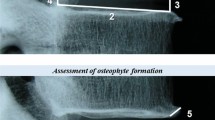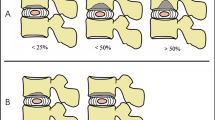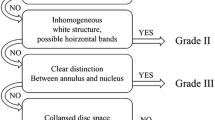Abstract
A new radiographic grading system for a more objective assessment of lumbar intervertebral disc degeneration has been described and tested in Part I of this study. The aim of the present Part II of the study was to adapt this system to the cervical spine, and to test it for validity and interobserver agreement. Some modifications of the grading system described in Part I were necessary to make it applicable to the cervical spine. Its basic structure, however, stayed untouched. The three variables “Height Loss”, “Osteophyte Formation” and “Diffuse Sclerosis” first have to be graded individually. Then, the “Overall Degree of Degeneration” is assigned on a four-point scale from 0 (no degeneration) to 3 (severe degeneration). For validation, the radiographic degrees of degeneration of 28 cervical discs were compared to the respective macroscopic ones, which were defined as “real” degrees of degeneration. The interobserver agreement was determined between one experienced and one unexperienced observer using the radiographs of 57 cervical discs. Quadratic weighted Kappa coefficients (κ) with 95% confidence limits (95% CL) were used for statistical evaluation. The validation of the new version of the radiographic grading system showed a moderate agreement with the “real”, macroscopic overall degree of degeneration (κ=0.599, 95% CL 0.421–0.786). In 64% of all discs the “real” overall degree of degeneration was underestimated but never overestimated. This underestimation, however, was much less pronounced and the Kappa coefficients were significantly higher for the three variables: Height Loss, Osteophyte Formation, and Diffuse Sclerosis separately. The agreement between the radiographic ratings of the experienced and the unexperienced observer was substantial for the overall degree of degeneration (κ=0.688, 95% CL 0.580–0.796), almost perfect for the variable, Height Loss, moderate for Osteophyte Formation and fair for Diffuse Sclerosis. In conclusion, we believe that the new version of the radiographic grading system is a sufficiently valid and reliable tool to quantify the degree of degeneration of individual cervical intervertebral discs. In comparison to the version for the lumbar spine described in Part I, however, a slightly higher tendency to underestimate the “real” overall degree of degeneration and somewhat higher interobserver differences have to be expected.





Similar content being viewed by others
References
Benneker LM, Heini PF, Anderson SE, Alini M, Ito K (2005) Correlation of radiographic and MRI parameters to morphological and biochemical assessment of intervertebral disc degeneration. Eur Spine J 14(1):27–35
Brooker AE, Barter RW (1965) Cervical spondylosis. a clinical study with comparative radiology. Brain 88(5):925–936
Collins DH (1949) The pathology of articular and spinal diseases. Edward Arnold & Co, London
Cote P, Cassidy JD, Yong-Hing K, Sibley J, Loewy J (1997) Apophysial joint degeneration, disc degeneration, and sagittal curve of the cervical spine. Can they be measured reliably on radiographs? Spine 22(8):859–864
Fleiss J, Cohen J (1973) The equivalence of weighted kappa and the intraclass correlation coefficient as measures of reliability. Educ Psychol Meas 33:613–619
Friedenberg ZB, Miller WT (1963) Degenerative disc disease of the cervical spine. J Bone Joint Surg Am 45:1171–1178
Frobin W, Leivseth G, Biggemann M, Brinckmann P (2002) Vertebral height, disc height, posteroanterior displacement and dens-atlas gap in the cervical spine: precision measurement protocol and normal data. Clin Biomech (Bristol, Avon) 17(6):423–431
Fujiwara A, Lim TH, An HS, et al. (2000) The effect of disc degeneration and facet joint osteoarthritis on the segmental flexibility of the lumbar spine. Spine 25(23):3036–3044
Hirsch C (1972) Some morphological changes in the cervical spine during ageing. In: Hirsch C, Zotterman Y (eds) Cervical pain. Pergamon, New York, pp 21–32
Kellgren JH, Jeffrey MR, Ball J (1963) The epidemiology of chronic rheumatism. Vol. II: Atlas of standard radiographs of arthritis. Blackwell, Oxford, pp 14–19
Kellgren JH, Lawrence JS (1952) Rheumatism in miners. II. X-ray study. Br J Ind Med 9(3):197–207
Kellgren JH, Lawrence JS (1957) Radiological assessment of osteo-arthrosis. Ann Rheum Dis 16(4):494–502
Kettler A and Wilke H-J (2005) Review of existing grading systems for cervical and lumbar disc and facet joint degeneration. Eur Spine J (accepted)
Landis JR, Koch GG (1977) The measurement of observer agreement for categorical data. Biometrics 33(1):159–174
Lehto IJ, Tertti MO, Komu ME, Paajanen HE, Tuominen J, Kormano MJ (1994) Age-related MRI changes at 0.1 T in cervical discs in asymptomatic subjects. Neuroradiology 36(1):49–53
Macnab I (1975) Cervical spondylosis. Clin Orthop 109:69–77
Pfirrmann CW, Metzdorf A, Zanetti M, Hodler J, Boos N (2001) Magnetic resonance classification of lumbar intervertebral disc degeneration. Spine 26(17):1873–8
SAS (1999) SAS Institute Inc.: Cary, NC, USA
Schellhas KP, Smith MD, Gundry CR, Pollei SR (1996) Cervical discogenic pain. Prospective correlation of magnetic resonance imaging and discography in asymptomatic subjects and pain sufferers. Spine 21(3):300–311; discussion 311–312
Schneiderman G, Flannigan B, Kingston S, Thomas J, Dillin WH, Watkins RG (1987) Magnetic resonance imaging in the diagnosis of disc degeneration: correlation with discography. Spine 12(3):276–281
Silberstein CE (1965) The evolution of degenerative changes in the cervical spine and an investigation into the “Joints of Luschka”. Clin Orthop 40:184–204
Tertti M, Paajanen H, Laato M, Aho H, Komu M, Kormano M (1991) Disc degeneration in magnetic resonance imaging. A comparative biochemical, histologic, and radiologic study in cadaver spines. Spine 16(6):629–634
Thompson JP, Pearce RH, Schechter MT, Adams ME, Tsang IK, Bishop PB (1990) Preliminary evaluation of a scheme for grading the gross morphology of the human intervertebral disc. Spine 15(5):411–415
Töndury G (1972) The behaviour of the cervical discs during life. In: Hirsch C, Zotterman Y (eds) Cervical pain. Pergamon, New York, pp 59–66
Viikari-Juntura E, Raininko R, Videman T, Porkka L (1989) Evaluation of cervical disc degeneration with ultralow field MRI and discography. An experimental study on cadavers. Spine 14(6):616–619
Acknowledgement
The authors gratefully acknowledge the Deutsche Arthrose-Hilfe e.V. for financial support.
Author information
Authors and Affiliations
Corresponding author
Additional information
Part I of this article can be found at http://dx.doi.org/10.1007/s00586-005-1029-9
Rights and permissions
About this article
Cite this article
Kettler, A., Rohlmann, F., Neidlinger-Wilke, C. et al. Validity and interobserver agreement of a new radiographic grading system for intervertebral disc degeneration: Part II. Cervical spine. Eur Spine J 15, 732–741 (2006). https://doi.org/10.1007/s00586-005-1037-9
Received:
Revised:
Accepted:
Published:
Issue Date:
DOI: https://doi.org/10.1007/s00586-005-1037-9




